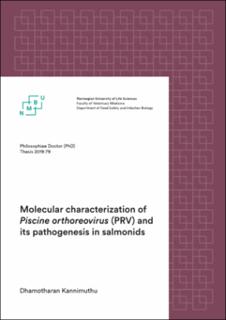| dc.description.abstract | Piscine orthoreovirus (PRV) is a virus of salmonid fish. PRV has been associated with different diseases in various salmonid fish species, including heart and skeletal muscle inflammation (HSMI) in Atlantic salmon and more recently a disease resembling HSMI in rainbow trout. In general, PRV appears to be widely distributed, with detection in diseased as well as non-diseased fish. For some of the diseases, a causative relationship has been established, confirming PRV as the etiological agent of the disease, whereas for others the disease association is questioned. The combination of multiple salmonid species and discovery of multiple PRV variants, compose a complex landscape to study disease association. This calls for basic studies revealing the characteristics of the virus, combined with targeted and controlled experiments to settle disease association. The present thesis focuses on PRV-1 infection of Atlantic salmon and PRV-3 in Rainbow trout. The work encompasses the basic characterization of PRV and provides important information on the pathogenesis and disease association.
The first study addressed potential virulence differences between PRV-1 strains infecting Atlantic salmon. A full genome sequence analysis of different PRV-1 strains was conducted. The analysis of HSMI-associated PRV-1 strains and low virulent North American pacific coast (NAPC) isolates revealed connection foremost with genomic segments S1 and M2 and the HSMI trait. Reassortment of these two genomic segments and/or possibly the accumulation of mutations have contributed to the evolution of the virulent strains. Some of the PRV-1 isolates showed segment reassortments, indicating that this mechanism contributes to PRV evolution. PRV strains from archived samples, revived by in vivo propagation and full-genome sequenced, confirmed the presence of different variants of PRV during the pre-HSMI period in Norway. The HSMI associated genotypes are adapted to farmed Atlantic salmon, as indicated by the sequences of S1 and M2 segments being stable for the last 20 years.
The second study looked into viral kinetics, the differential peak of PRV RNA and protein during HSMI development. Following experimental infections, irrespective of the challenge method, PRV-1 infection of erythrocytes has a clear peak. The virus particles release from erythrocytes into plasma in large numbers in the peak period and spread to other organs. Cardiomyocytes are particularly permissive for infection with PRV-1, and the resulting immune response to the infected cells causes the typical HSMI histopathological changes, i.e. epicarditis, myocarditis in spongy and compact cardiomyocytes. The immune response clears the virus from the cardiomyocytes. However, the virus persists in erythrocytes as observed by detection of PRV RNA by RT-qPCR and in situ staining.
The third study focused on a new PRV variant infecting rainbow trout, which had been associated with an HSMI-like disease. Genetic and antigenic characterization of the virus were conducted to study the relation to PRV-1. Based on full genome sequence analysis, the virus was assessed as a new PRV variant and named PRV-3. The overall nucleotide identity to PRV-1 was 80%. Western blot analysis showed cross-reaction with antibodies raised against PRV-1 proteins for all homolog PRV-3 proteins tested. The antigenic analysis did not indicate that PRV-3 was a new serotype. The protein structure and functions are conserved between PRV-1 and PRV-3. The screening for PRV-3 by RT-qPCR revealed the presence of this virus in Denmark, Italy, Germany, and Scotland.
The fourth study continued to focus on PRV-3 and aimed to look at the relationship between PRV-3 and the HSMI-like disease in rainbow trout. A ten-week long cohabitation challenge experiment was conducted to prove a causal relationship with the disease. The virus was purified and shown to be morphologically indistinguishable from PRV-1 in transmission electron microscopy (TEM). The study showed that PRV-3 infection causes inflammation and pathological changes in the heart of both shedders and cohabitants. The viral infection induced innate antiviral immune responses, as measured by gene expression analysis. The PRV-3 infection in rainbow trout showed differential viral kinetics compared to PRV-1 in Atlantic salmon. PRV-3 is cleared in rainbow trout, whereas PRV-1 persists in erythrocytes of Atlantic salmon.
To summarize, 1) We have shown that PRV-1 was present in Norway before the report of HSMI appeared. The M2/S1 segment pair links to the evolution of virulence in PRV-1 in Atlantic salmon. 2) The PRV peak in erythrocytes coincides in time with infection of heart and liver. PRV-1 is cleared from cardiomyocytes, but persist in erythrocytes. 3) The genetic and antigenic characterization of PRV from rainbow trout showed close relation to PRV-1. The new virus is a distinct PRV subtype, named as PRV-3. 4) PRV-3 is present in rainbow trout and brown trout in other European countries. 5) Finally, we proved that PRV-3 causes heart pathology in rainbow trout using purified PRV-3 in a challenge study. | en_US |

